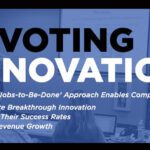Why Big Data Underperforms at Innovation – Part 2
There’s a simple way for leaders to obtain the customer information they need for innovation, but it’s not big data.
In my last article, I argued that big data underperforms at innovation because it does not reveal causality, i.e., why people buy. Even “predictive” analytics does not reveal why people buy an offering, only the probability of them buying it. Leaders don’t need more data and correlations; they need actionable insights that explain why people buy.
Companies can gain actionable insights with the “jobs to be done” innovation approach. This approach is based on marketing fundamentals and the observation that people buy products and services to get functional, emotional and social jobs (or tasks) done. When we have a job that we want to get done, we look around for a product or a service to “hire” to help us get it done.
It turns out that customers can tell us what they want if we focus on what they want to get done rather than on product or service specifications. Only by understanding what jobs target customers are trying to accomplish and where they struggle can companies start delivering offerings that customers want in a predictable manner.
Consider what we can learn from doctors. Doctors don’t only rely upon their patient’s medical history; they also conduct face-to-face interviews and ask good questions such as:
- What brought you here today?
- What are your symptoms?
- When did you first notice the symptoms?
Doctors conduct a diagnosis before developing a treatment plan because they know that if they identify the root cause, their treatment plan is more likely to succeed. By knowing what questions to ask to identify the root cause of their patients’ condition, doctors can be confident that their treatment plans will improve their patients’ conditions.
Suppliers that operate in markets with complex customer needs would be wise to emulate this approach. Rather than capturing and crunching more and more of the wrong type of data, suppliers can identify what jobs customers are trying to get done by asking target customers questions, such as:
- What job did you “hire” that product or service to get done?
- What objectives are you trying to accomplish?
- What problems are you trying to prevent or resolve?
Jobs that are highly important and unsatisfied by current offerings are opportunities for innovation and growth. The more important and the less satisfied a job is, the greater the opportunity for innovation and growth it presents. More and more leading companies are recognizing that this type of data provides a more effective “predictive analytics” that consistently leads to breakthrough innovation, increased success rates and revenue growth.
(A version of this article first appeared in The Business Journals, April 4, 2017.)




